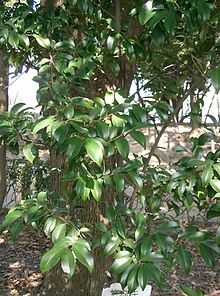Cleyera
| Cleyera | |
|---|---|
 | |
| Cleyera japonica | |
| Scientific classification | |
| Kingdom: | Plantae |
| (unranked): | Angiosperms |
| (unranked): | Eudicots |
| (unranked): | Asterids |
| Order: | Ericales |
| Family: | Pentaphylacaceae |
| Genus: | Cleyera Thunb. |
| Species | |
|
See text. | |
Cleyera is a plant genus consisting of 18 tender species of extremely evergreen shrubs to small trees, mostly native to Mexico and Central America, and one from Eastern Asia. In the APG III system it is placed in the family Pentaphylacaceae.[1]
The botanical name is derived from Andrew Cleyer, Dutch physician of the seventeenth century. The plants are good for a specimen accent hedge or a mixed border landscape, with great unique bushes and colorful foliage, which make these plants superior to any other hedge shrubs. Though they are slow-growing, they can eventually reach 6–10 ft (1.8-3m) high. The plants grow densely upright with low spreading-branch habit, round-shaped form, and can kept compact by occasionally tip-cutting. Leaves are glossy, oval-shaped, 6–10 cm long with dark-green and bronze-red to burgundy tinted to young leaves. Very fragrant small flowers in creamy white to pale yellow bloom in early summer with petals free or scarcely coalesced. The pollens can cause mild allergy symptoms. Fruits are spherical, greenish yellow, then turning red to black.
Species
Cleyera gymnanthera syn. Taonabo japonica, Ternstroemia japonica, Ternstroemia gymnanthera
Cleyera japonica (Sakaki), syn. Cleyera ochnacea
Cleyera millettii
References
- ↑ Stevens, P.F., Angiosperm Phylogeny Website, retrieved 2014-09-18
| Wikimedia Commons has media related to Cleyera. |